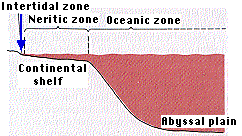| Index to this page |

Some of these regions are quite productive. Many of their inhabitants have adaptations that enable them to survive periodic exposure to the air and wave action.
Located over the ocean basins. Here, too, net productivity is pretty much limited to the depths that light can reach. The producers are planktonic algae that support secondary and higher consumers (e.g., fish) in the nekton.
Despite its diversity of life, the net productivity of the open ocean is little better than that of a desert [View].
This dark, relatively unvarying region is largely inhabited by sparse populations of bottom-dwelling organisms that make up the benthos. These are consumers and decomposers who depend on the organic matter drifting down from the upper portions of the sea.
An exception: the communities around rifts. Rifts are spreading cracks in the sea floor where continental drift is taking place. Although no light reaches here, net productivity does occur.
Chemoautotrophic bacteria and archaea manufacture food using energy secured by oxidizing the sulfur flowing out of the cracks ("black smokers").These microbes support a large population of animals, e.g., tube worms. Some of these worms harbor chemoautotrophic microbes within their tissues which probably supply them with the bulk of their calories.
| Link to Freshwater Ecosystems |
| Welcome&Next Search |